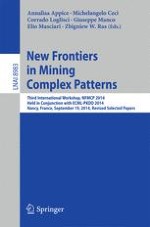2015 | Book
New Frontiers in Mining Complex Patterns
Third International Workshop, NFMCP 2014, Held in Conjunction with ECML-PKDD 2014, Nancy, France, September 19, 2014, Revised Selected Papers
Editors: Annalisa Appice, Michelangelo Ceci, Corrado Loglisci, Giuseppe Manco, Elio Masciari, Zbigniew W. Ras
Publisher: Springer International Publishing
Book Series : Lecture Notes in Computer Science
